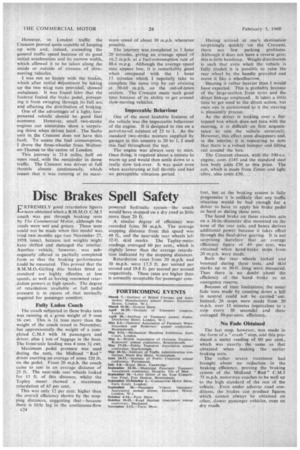Disc Brakes Spell Safety
Page 70

If you've noticed an error in this article please click here to report it so we can fix it.
EEXTREMELY good retardation figures were obtained when a B,M.M.O. C.M.5 coach was put through braking tests by The Cornmercial Motor, although the roads were wet and greasy. These tests could not be made when this model was tried two months ago (see November 27. 1959, issue), because test weights might have shifted and damaged the interior. Another. vehicle, however, was subsequently offered in partially completed form so that the braking performance could be measured. This proved that the B.M.M.0.-Girling disc brakes fitted as standard arc highly effective at low speeds. as well as having renowned retardation powers at high speeds. The degree of retardation available at full pedal pressure is in excess of that normally required for passenger comfort.
Fully Laden Coach The coach subjected to these brake tests was running at a gross weight of 9 tons 16 cwt. This is 14 tons more than the weight of the coach tested in November, hut approximately the weight of a completed C.M.5 with 34 passengers and driver, plus 4 ton of luggage in the boot. The front-axle loading was 4 tons 3 cwt.
• Maximum pedal pressure was used during the tests, the Midland " Red " driver exerting an average of some 320 lb. on the pedal. From 20 m.p.h. the coach came to rest in an average distance of 25 ft. The near-side rear wheels locked for 15 ft. of this distance, whilst the Tapley meter showed a maximum retardation of 65 per cent.
This was only 12 per cent. higher than the overall efficiency shown by the stopping distances, suggesting that—because there is little lag in the continuous-flow e24 powered hydraulic system—the coach would have stopped on a dry road in little more than 20 ft.
A similar degree of efficiency was recorded from 30 m.p.h. The average stopping distance from this speed was 49 ft., and the near-side rear wheels left 32-ft. skid marks. The Tapley-meter readings averaged 60 per cent., which is slightly lower than the average retardation indicated by the stopping distances.
Retardation rates from 20 m.p.h. and 30 m.p.h. were 17.3 ft. per second per second and 19.8 ft. per second per second respectively. These rates are higher than is normally acceptable for passenger com fort, but as the braking system is fully progressive it is unlikely that any traffic situation would be bad enough for a driver to have to apply his brake pedal as hard as during these tests.
The hand brake on these coaches acts on a 16-in.-diameter disc mounted on the nose of the rear axle, and hence derives additional power because it takes effect through the final-drive gearing. It is not surprising therefore that an average efficiency figure of 49 per cent. was obtained when hand-brake stops from 20 m.p.h. were made.
Both the rear wheels locked and bounced during these tests. and skid marks up to 30-ft. long were measured. Thus there is no doubt about the efficiency of the hand brake as an emergency reserve.
Because of time limitations, the usual fade tests made by coasting down a hill in neutral could not be carried out. Instead. 26 stops were made from 30 m.p.h. over 13 minutes (equivalent to a stop every 30 seconds) and these averaged 50-per-cent. efficiency.
No Fade Obtained The last stop, however, was made in the form of a crash" stop, and this produced a meter reading of 60 per cent., which was exactly the same as • that obtained when making the earlier braking tests.
The rather severe treatment had brought about no reduction in the braking efficiency, proving the braking system of the Midland " Red" C.M.5 75 m.p.h, motorway coaches to be well up to the high standard of the rest of the vehicle. Even under adverse road conditions, the brakes can produce figures which cannot always be obtained on other. slower passenger vehicles, even on dry roads.




























































































































